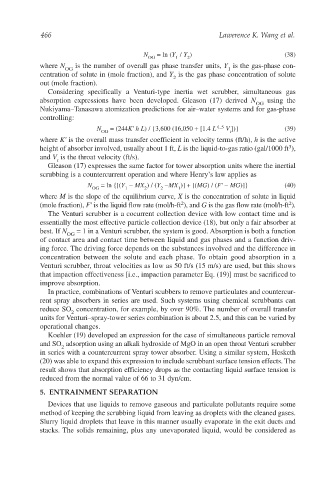Page 494 - Air Pollution Control Engineering
P. 494
12_ch_wang.qxd 05/05/2004 5:26 pm Page 466
466 Lawerence K. Wang et al.
N = ln (Y / Y ) (38)
OG 1 2
where N is the number of overall gas phase transfer units, Y is the gas-phase con-
OG 1
centration of solute in (mole fraction), and Y is the gas phase concentration of solute
2
out (mole fraction).
Considering specifically a Venturi-type inertia wet scrubber, simultaneous gas
absorption expressions have been developed. Gleason (17) derived N using the
OG
Nukiyama–Tanasawa atomization predictions for air–water systems and for gas-phase
controlling:
N = (244K'hL) / {3,600 (16,050 + [1.4 L' 1.5 V ])} (39)
OG t
where K' is the overall mass transfer coefficient in velocity terms (ft/h), h is the active
3
height of absorber involved, usually about 1 ft, L is the liquid-to-gas ratio (gal/1000 ft ),
and V is the throat velocity (ft/s).
t
Gleason (17) expresses the same factor for tower absorption units where the inertial
scrubbing is a countercurrent operation and where Henry’s law applies as
N = ln {[(Y − MX ) / (Y −MX )] + [(MG) / (F' − MG)]} (40)
OG 1 2 2 1
where M is the slope of the equilibrium curve, X is the concentration of solute in liquid
2
2
(mole fraction), F' is the liquid flow rate (mol/h-ft ), and G is the gas flow rate (mol/h-ft ).
The Venturi scrubber is a cocurrent collection device with low contact time and is
essentially the most effective particle collection device (18), but only a fair absorber at
best. If N = 1 in a Venturi scrubber, the system is good. Absorption is both a function
OG
of contact area and contact time between liquid and gas phases and a function driv-
ing force. The driving force depends on the substances involved and the difference in
concentration between the solute and each phase. To obtain good absorption in a
Venturi scrubber, throat velocities as low as 50 ft/s (15 m/s) are used, but this shows
that impaction effectiveness [i.e., impaction parameter Eq. (19)] must be sacrificed to
improve absorption.
In practice, combinations of Venturi scubbers to remove particulates and countercur-
rent spray absorbers in series are used. Such systems using chemical scrubbants can
reduce SO concentration, for example, by over 90%. The number of overall transfer
2
units for Venturi–spray-tower series combination is about 2.5, and this can be varied by
operational changes.
Koehler (19) developed an expression for the case of simultaneous particle removal
and SO adsorption using an alkali hydroxide of MgO in an open throat Venturi scrubber
2
in series with a countercurrent spray tower absorber. Using a similar system, Hesketh
(20) was able to expand this expression to include scrubbant surface tension effects. The
result shows that absorption efficiency drops as the contacting liquid surface tension is
reduced from the normal value of 66 to 31 dyn/cm.
5. ENTRAINMENT SEPARATION
Devices that use liquids to remove gaseous and particulate pollutants require some
method of keeping the scrubbing liquid from leaving as droplets with the cleaned gases.
Slurry liquid droplets that leave in this manner usually evaporate in the exit ducts and
stacks. The solids remaining, plus any unevaporated liquid, would be considered as

